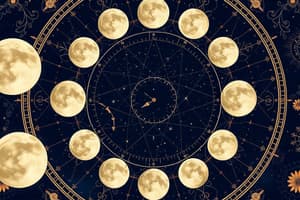Podcast
Questions and Answers
चंद्रमा के विभिन्न चरण क्या हैं?
चंद्रमा के विभिन्न चरण क्या हैं?
- 9
- 8 (correct)
- 7
- 6
चंद्रमा के गठन का सिद्धांत क्या है?
चंद्रमा के गठन का सिद्धांत क्या है?
- परमाणु विस्फोट
- विशाल प्रभाव परिकल्पना (correct)
- परमाणु संक्षिप्त
- गुरुत्वाकर्षण की थ्योरी
ग्रहण क्या है?
ग्रहण क्या है?
- पृथ्वी द्वारा चंद्रमा पर छाया डालना
- चंद्रमा द्वारा पृथ्वी और सूर्य के बीच में आना (correct)
- सूर्य और पृथ्वी के बीच में चंद्रमा का आना
- चंद्रमा का पृथ्वी से टकराना
चंद्रमा की कक्षा कैसी है?
चंद्रमा की कक्षा कैसी है?
पहला मानव अंतरिक्ष उड़ान किसका था?
पहला मानव अंतरिक्ष उड़ान किसका था?
चंद्रमा की कक्षीय गति क्या है?
चंद्रमा की कक्षीय गति क्या है?
पहला सफल सॉफ्ट लैंडिंग किसका था?
पहला सफल सॉफ्ट लैंडिंग किसका था?
नासा के चंद्रमा के ऑर्बिटर मिशन का नाम क्या है?
नासा के चंद्रमा के ऑर्बिटर मिशन का नाम क्या है?
चीन के चंद्रमा मिशन का नाम क्या है?
चीन के चंद्रमा मिशन का नाम क्या है?
Flashcards are hidden until you start studying
Study Notes
Lunar Phases
- The Moon orbits the Earth in approximately 29.5 days, resulting in different amounts of illuminated surface area visible from Earth
- 8 distinct phases:
- New Moon: Side facing Earth is not illuminated by the Sun
- Waxing Crescent: Increasing amount of illuminated surface area
- First Quarter: Right half of illuminated surface area is visible
- Waxing Gibbous: Continuously increasing illuminated surface area
- Full Moon: Entire illuminated surface area is visible
- Waning Gibbous: Decreasing amount of illuminated surface area
- Last Quarter: Left half of illuminated surface area is visible
- Waning Crescent: Decreasing amount of illuminated surface area
Moon Formation
- Giant Impact Hypothesis: Moon formed from debris left over after a massive collision between Earth and a Mars-sized object called Theia
- Debris coalesced to form the Moon, which eventually became tidally locked to Earth
- Moon's composition is similar to Earth's, but with some differences in isotopic signatures
Eclipse
- Occurs when the Moon passes between the Earth and the Sun, blocking sunlight from reaching the Earth
- Types of eclipses:
- Solar eclipse: Moon blocks direct sunlight, casting a shadow on the Earth
- Lunar eclipse: Earth blocks sunlight from reaching the Moon, casting a shadow on the Moon
- Eclipse cycles: Saros (18 years, 11 days), Inex (29 years), and Tritos (398 years)
Moon Orbit
- Elliptical orbit: Moon's distance from Earth varies from 356,400 km (perigee) to 405,500 km (apogee)
- Orbital speed: approximately 1 km/s
- Tidal interactions: Moon's gravity causes Earth's oceans to bulge, while Earth's gravity slows the Moon's orbit, increasing its distance from Earth
Space Exploration
- First human spaceflight: Soviet Union's Luna 2, 1959
- First successful soft landing: Soviet Union's Luna 9, 1966
- First manned mission: United States' Apollo 11, 1969 (Neil Armstrong and Edwin "Buzz" Aldrin)
- Recent and ongoing missions:
- NASA's Lunar Reconnaissance Orbiter (2009)
- NASA's LADEE (2013)
- China's Chang'e 4 (2019)
चंद्र фасे
- पृथ्वी के चारों ओर चंद्रमा 29.5 दिन में परिक्रमा करता है, जिसके परिणामस्वरूप पृथ्वी से दिखने वाले प्रकाशित सतह के क्षेत्र में अलग-अलग मात्रा होती है
- 8 विभिन्न фасे:
- नव चंद्र: पृथ्वी की ओर मुख किया हुआ सurface नहीं है प्रकाशित सूरज से
- वृद्धि संक्रमित: प्रकाशित सतह के क्षेत्र में वृद्धि हो रही है
- प्रथम तिमाही: दाहिने आधे प्रकाशित सतह के क्षेत्र दिखाई दे रहे हैं
- वृद्धि गतिशील: निरंतर प्रकाशित सतह के क्षेत्र में वृद्धि हो रही है
- पूर्ण चंद्र: पूरे प्रकाशित सतह के क्षेत्र दिखाई दे रहे हैं
- अवनत गतिशील: प्रकाशित सतह के क्षेत्र में कमी हो रही है
- अंतिम तिमाही: बाएं आधे प्रकाशित सतह के क्षेत्र दिखाई दे रहे हैं
- अवनत संक्रमित: प्रकाशित सतह के क्षेत्र में कमी हो रही है
चंद्र निर्माण
- विशाल प्रभाव सिद्धांत: चंद्र पृथ्वी और मंगल आकार के объект थिया के बीच हुए विशाल संघट्टन से छोड़े गए मलबे से बना है
- मलबे ने चंद्र का निर्माण किया जिसने बाद में पृथ्वी के साथ टिडली लॉक हो गया
- चंद्र की संरचना पृथ्वी के समान है, लेकिन कुछアイソटोपिक हस्ताक्षर में अंतर हैं
ग्रहण
- जब चंद्र पृथ्वी और सूरज के बीच से गुजरता है, तो पृथ्वी पर सीधे सूरज की रोशनी को रोकता है
- ग्रहण के प्रकार:
- सौर ग्रहण: चंद्र सीधे सूरज की रोशनी को रोकता है, पृथ्वी पर एक छाया कास्त करता है
- चंद्र ग्रहण: पृथ्वी सूरज की रोशनी को चंद्र पर रोकता है, एक छाया कास्त करता है
- ग्रहण चक्र: सारोस (18 वर्ष, 11 दिन), इनेक्स (29 वर्ष), और ट्रिटोस (398 वर्ष)
चंद्र कक्षा
- अंडाकार कक्षा: चंद्र की पृथ्वी से दूरी 356,400 km (पेरिगी) से 405,500 km (एपोजी) तक बदलती है
- कक्षा गति: लगभग 1 km/s
- टिडली बातचीत: चंद्र के गुरुत्वाकर्षण के कारण पृथ्वी के महासागरों में सूजन आती है, जबकि पृथ्वी के गुरुत्वाकर्षण के कारण चंद्र की कक्षा धीमी होती है, पृथ्वी से उसकी दूरी बढ़ती है
अंतरिक्ष अन्वेषण
- पहली मानव अंतरिक्ष उड़ान: सोवियत संघ के लूना 2, 1959
- पहली सफल सॉफ्ट लैंडिंग: सोवियत संघ के लूना 9, 1966
- पहली मानव मिशन: संयुक्त राज्य अमेरिका के अपोलो 11, 1969 (नील आर्मस्ट्रांग और एडविन "बज" एल्ड्रिन)
- हाल के और चल रहे मिशन:
- नासा के लूनर रिकनиссेंस ऑर्बिटर (2009)
- नासा के लेडी (2013)
- चीन के चांग'E 4 (2019)
Studying That Suits You
Use AI to generate personalized quizzes and flashcards to suit your learning preferences.




